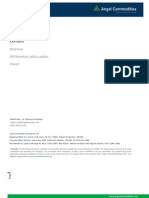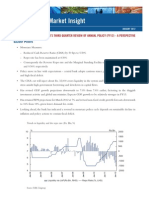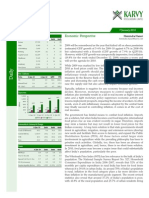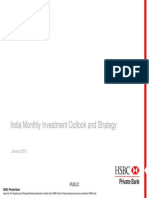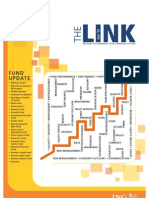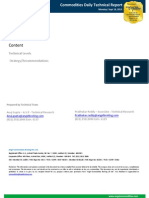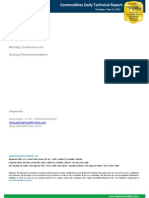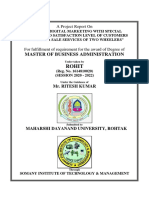RBI Monetary Policy Review, 17th June 13
RBI Monetary Policy Review, 17th June 13
Uploaded by
Angel BrokingCopyright:
Available Formats
RBI Monetary Policy Review, 17th June 13
RBI Monetary Policy Review, 17th June 13
Uploaded by
Angel BrokingOriginal Description:
Copyright
Available Formats
Share this document
Did you find this document useful?
Is this content inappropriate?
Copyright:
Available Formats
RBI Monetary Policy Review, 17th June 13
RBI Monetary Policy Review, 17th June 13
Uploaded by
Angel BrokingCopyright:
Available Formats
Mid-Quarter Monetary Policy Review
Monday | June 17, 2013
Content
RBI silent on interest rates Challenge for the Indian Economy Indian Economic Scenario World Currency Markets
Reena Rohit Chief Manager Non-Agri Commodities and Currencies reena.rohit@angelbroking.com (022) 3935 8134
Angel Commodities Broking Pvt. Ltd. Registered Office: G-1, Ackruti Trade Centre, Rd. No. 7, MIDC, Andheri (E), Mumbai - 400 093. Corporate Office: 6th Floor, Ackruti Star, MIDC, Andheri (E), Mumbai - 400 093. Tel: (022) 2921 2000 CX Member ID: 12685 / FMC Regn No: MCX / TCM / CORP / 0037 NCDEX : Member ID 00220 / FMC Regn No: NCDEX / TCM / CORP / 0302
Disclaimer: The information and opinions contained in the document have been compiled from sources believed to be reliable. The company does not warrant its accuracy, completeness and correctness. The document is not, and should not be construed as an offer to sell or solicitation to buy any commodities. This document may not be reproduced, distributed or published, in whole or in part, by any recipient hereof for any purpose without prior permission from Angel Commodities Broking (P) Ltd. Your feedback is appreciated on commodities@angelbroking.com
Page
www.angelcommodities.com
Mid-Quarter Monetary Policy Review
Monday | June 17, 2013
Reserve Bank of India Silent on Interest Rates
Repo Rate 7.25% Citing growth-inflation dynamics and recent developments in the external sector, the Reserve Bank of India (RBI) kept interest rates unchanged as Reverse Repo Rate 6.25 % expected. Indications for further changes in interest rates in the July13 Cash Reserve Ratio 4% policy are currently mute but may change over time, given that the monsoon this year is expected to be normal, thus reducing the supply-side Bank Rate 8.25% pressure and thereby easing inflation. This scenario would lead to the RBI reducing rates in order to boost growth. In the current policy, the central bank faced pressure from two sides i.e. either to boost growth by lowering interest rates or tackle inflation, which is an existing issue especially due to the weaker Rupee, which is leading to increase in costs of commodity imports.
Fall in the WPI to 4.7 percent has not been a strong enough factor for the central bank to reduce interest rates as food inflation remains high. While factors like distribution and supply of food are affecting food inflation, measures to tackle the same need to be introduced. A good monsoon progress on a pan-India scale ahead of time will help to bring down food inflation in the coming months. Developments on the external sector front, being one of the major factors that drove the RBIs decision, need to be looked at closely. Sharp depreciation in the Rupee along with a widening of the trade deficit due to a surge in gold imports has restricted interest rate cuts by the RBI. In its review, the central bank has indicated that the key to boosting economic growth could be done through increasing investment by creating a favorable and conducive environment for private investment, improving project clearance and raising the role of public investment. This move by the RBI has largely dampened sentiments at a time when the world economy is suddenly witnessing a slowdown in growth momentum. Recent measures in order to reduce the Current Account Deficit (CAD) by way of curbing gold imports through restricting its supply and increasing customs duty, it looks like the RBI is using indirect measures to reduce economic hurdles and is also applying the same strategy to boost economic growth.
Repo Rate (%)
10.2 9.2 8.2 7.2 6.2
8 7.5
Reverse Repo Rate (%)
7.5 6.5
9 8.5 7 6.5 6.75 8.5
7
6.5 6 5.5
6 5.5
6 5.25
6.25
7.25
5 4.5 4 3.5 3
6
5.2 4.2
4.5 3.25
27-04-2001 28-05-2001 23-10-2001 28-03-2002 30-10-2002 3-03-2003 19-03-2003 25-08-2003 27-10-2004 26-10-2005 8-06-2006 31-10-2006 31-03-2007 25-06-2008 20-10-2008 8-12-2008 5-03-2009 19-03-2010 2-07-2010 16-09-2010 25-01-2011 3-05-2011 26-07-2011 25-10-2011 17-04-2012 19-03-2013 17-06-2013
4.75
27-04-2001 28-05-2001 23-10-2001 28-03-2002 30-10-2002 3-03-2003 19-03-2003 25-08-2003 27-10-2004 26-10-2005 8-06-2006 31-10-2006 31-03-2007 25-06-2008 20-10-2008 8-12-2008 5-03-2009 19-03-2010 2-07-2010 16-09-2010 25-01-2011 3-05-2011 26-07-2011 25-10-2011 17-04-2012 19-03-2013 17-06-2013
Page
In each of its policy reviews in the past, the RBI had cut interest rates to boost growth.
www.angelcommodities.com
Mid-Quarter Monetary Policy Review
Monday | June 17, 2013
Challenge for the Indian economy Sustain capital inflows and increase investments
Since the onset of the global financial crisis, world markets have placed great emphasis on the monetary policy developments in the major economies. From the Asian market context, India is one of the major economies and the monetary policy decisions by the Reserve Bank of India (RBI) would most likely impact investment decisions globally. By keeping interest rates steady, the role of the central bank becomes even more challenging given the current weak domestic economic scenario. The weakness in the Rupee has already raised a host of economic problems - from raising the import bill, as major commodities are imported to making the CAD rise, which has touched elevated levels. Also, with the US economy on a growth trajectory, there are large expectations that investment flows into India could be affected. Although at a slow pace, the US is witnessing a rise in economic activity as opposed to previous years and that its job market is also reviving. With improving US economic data and expectations of the monetary stimulus pullback, the Indian economy will have to gear up in order to sustain capital inflows and increase the concentration of investments in India in order to mitigate the impact of a bounce back in the US. This is because, better economic prospects and treasury yields in the US will reduce investor concentration and participation in the Indian markets. Asia, in any case is seeing a marked slowdown, with China being at the forefront.
Net Investments vs. Rupee Movement (Monthly Avg)
57 56 55 54 53 52 51 40,000 35,000 30,000 25,000 20,000 15,000 10,000 5,000 0 -5,000 -10,000
50
49
Net Investments (Rs. Cr)
Source: RBI, Reuters, Angel Research
Rupee -Monthly Average
March13 has witnessed a slowdown in capital inflows, which is now a major concern to the Indian economy at large. Sharp appreciation in the Rupee was seen during Jan12 and Feb12, however only for a short period as a decline in investment flows led to depreciation in the currency. We could expect a repeat of a similar pattern if measures are not taken ahead of time. But a positive factor in this context is that the Federal Reserves withdrawal of stimulus measures is not expected to happen immediately, thereby buying time for the Indian economy to boost growth by implementation of aggressive measures.
Page
www.angelcommodities.com
Mid-Quarter Monetary Policy Review
Monday | June 17, 2013
Indian Economic Scenario
Indian Quarterly GDP Growth (%)
12 11 10 9 8 7 6 5
11.2 9.6 9.8 9.8
9.2
5.1 3.5
10/1/2005 10/1/2006 10/1/2007 10/1/2008 10/1/2010 10/1/2012
10/1/2009 10/1/2011
4
3
4.8
6/1/2012 2/1/2013
6/1/2005
2/1/2006
6/1/2006
2/1/2007
6/1/2007
2/1/2008
6/1/2008
2/1/2009
6/1/2009
2/1/2010
6/1/2011
Source: RBI, Reuters, Angel Research
Indian Economic growth has been on a declining trajectory from 2010 onwards. From a quarterly GDP of 11.2 percent in Q4FY2009-10 to growth of 4.8 percent in the Q4FY2012-13, deceleration in growth has had a major impact on the domestic currency market. Negative cues from the overall slowdown in the global economy also impacted India. Further growth will now be dependent on the course the world economic growth takes.
2011 Onwards Rupee has Weakened Sharply
12 11 10 9 8 52 50 48 46 44 56 54
7
6 5 4
Quarterly GDP (% Chg)
Source: RBI, Reuters, Angel Research
Average Rupee Value
The adjacent chart suggests that movement in the Rupee is strongly correlated with growth in the economy. Average value of the Rupee has moved according to the rise or fall in the economy. The Rupee depreciated considerably as GDP slipped from 11.2 percent in Q4FY2009 and continued its journey downwards. Between Q3FY2009-10 to Q2FY2011-12, average value of the Rupee stood between 44-45. Thereafter, it has traded above 50 levels and breached the 54-mark Q2FY2012-13 onwards.
Page
2/1/2012
6/1/2010
2/1/2011
www.angelcommodities.com
Mid-Quarter Monetary Policy Review
Monday | June 17, 2013
World Currency Markets
Apart from the expectations of Federal Reserves actions, it is the movement and the volatility in the Japanese Yen that is playing a major role in the world currency markets currently. Extreme and aggressive stimulus and boosting measures by the Bank of Japan have provided a quick boost to the Japanese markets. However, we feel that this rush of aggressive measures amid high fiscal strain would not be fruitful over the long run. Coming to the US, expectations with respect to the pullback in Federal Reserves bond-buying program have been factored in and markets are not anticipating an immediate withdrawal. Hence, in the next few months at least, the Feds monthly bond purchases are expected to continue, thereby keeping a check on the rise in the Dollar Index. This in turn would act as a positive factor for the Rupee, which has depreciated sharply over the year. The impact of RBIs policy review today is expected to be muted and further cues will be taken from the Federal Reserves monetary policy review which is scheduled for 18th 19th June13. We feel that the Federal Reserve would also buy time to judge the overall US economic scenario and slate this pullback over a long-term period. But statements by the Federal Reserve Chairman Ben Bernanke will provide further direction to the world equity and currency markets, and also to the Rupee.
Page
www.angelcommodities.com
You might also like
- Tutorial 2 QuestionsDocument4 pagesTutorial 2 Questionsguan junyanNo ratings yet
- Slide - 1: 2009. Between March 2010 and October 2011 The Reserve Bank Raised Its Policy RepoDocument3 pagesSlide - 1: 2009. Between March 2010 and October 2011 The Reserve Bank Raised Its Policy RepoGarrima ParakhNo ratings yet
- Week Ended September 21, 2012: Icici Amc Idfc Amc Icici BankDocument4 pagesWeek Ended September 21, 2012: Icici Amc Idfc Amc Icici BankBonthala BadrNo ratings yet
- RBI Monetary Policy UpdateDocument12 pagesRBI Monetary Policy UpdateSai KarthickNo ratings yet
- SEB Report: Asian Recovery - Please Hold The LineDocument9 pagesSEB Report: Asian Recovery - Please Hold The LineSEB GroupNo ratings yet
- 21MAYDocument3 pages21MAYritudahiya1389No ratings yet
- India RBI AI Apr19Document7 pagesIndia RBI AI Apr19Aman GuptaNo ratings yet
- RBI Monetary Policy UpdateDocument4 pagesRBI Monetary Policy UpdateAngel BrokingNo ratings yet
- Reserve Bank of India and Its Impact On The Indian Economy Post 1991 (Interest Rates, Exchange Rates and Inflation)Document7 pagesReserve Bank of India and Its Impact On The Indian Economy Post 1991 (Interest Rates, Exchange Rates and Inflation)Mrunal DubeyNo ratings yet
- Credit Policy 5 Reasons Why RBI Is Unlikely To ActDocument2 pagesCredit Policy 5 Reasons Why RBI Is Unlikely To ActShwetabh SrivastavaNo ratings yet
- RBI Monetary Policy - August 17Document3 pagesRBI Monetary Policy - August 17pappuNo ratings yet
- Policy ET Report For 20241009Document13 pagesPolicy ET Report For 20241009Salman KhanNo ratings yet
- Indian Election EconomyDocument1 pageIndian Election Economypathanfor786No ratings yet
- Market Outlook 16th March 2012Document4 pagesMarket Outlook 16th March 2012Angel BrokingNo ratings yet
- India Market Outlook Aug 2013Document4 pagesIndia Market Outlook Aug 2013sindu_lawrenceNo ratings yet
- Key Highlights:: Inflationary Pressures Overrides Downside Risks To GrowthDocument6 pagesKey Highlights:: Inflationary Pressures Overrides Downside Risks To Growthsamyak_jain_8No ratings yet
- Monetary Policy and Role of Banks: February 2015Document7 pagesMonetary Policy and Role of Banks: February 2015anik24No ratings yet
- Monetary Policy Review, 30th January 2013Document5 pagesMonetary Policy Review, 30th January 2013Angel BrokingNo ratings yet
- JUL 27 DBS Daily Breakfast SpreadDocument7 pagesJUL 27 DBS Daily Breakfast SpreadMiir ViirNo ratings yet
- RBI BulletinDocument118 pagesRBI Bulletintheresa.painter100% (1)
- Small could be better now: +1 σ Avg PE -1 σDocument3 pagesSmall could be better now: +1 σ Avg PE -1 σChandan AgarwalNo ratings yet
- FixedIncome January 2012Document3 pagesFixedIncome January 2012jayaram_mca83No ratings yet
- Market Outlook VRK100 14062011Document3 pagesMarket Outlook VRK100 14062011RamaKrishna Vadlamudi, CFANo ratings yet
- Fag 3qcy2012ruDocument6 pagesFag 3qcy2012ruAngel BrokingNo ratings yet
- Fearful Symmetry Nov 2011Document4 pagesFearful Symmetry Nov 2011ChrisBeckerNo ratings yet
- Monetory PolicyDocument21 pagesMonetory Policyharikrishna k sNo ratings yet
- Economic Report - 201603Document4 pagesEconomic Report - 201603bajax_lawut9921No ratings yet
- IndiaEconomicsOverheating090207 MFDocument4 pagesIndiaEconomicsOverheating090207 MFsdNo ratings yet
- Market Insight Q3FY12 RBI Policy Review Jan12Document3 pagesMarket Insight Q3FY12 RBI Policy Review Jan12poojarajeswariNo ratings yet
- RBI S Annual Monetary Policy: RBI Revised Repo Rate and CRR. Policy Expected To Be Aggresive Amid High InflationDocument27 pagesRBI S Annual Monetary Policy: RBI Revised Repo Rate and CRR. Policy Expected To Be Aggresive Amid High Inflationsheetal_sab19929665No ratings yet
- Impt. For AsignmentDocument4 pagesImpt. For AsignmentPranshu_Priyad_8742No ratings yet
- India Markets BriefDocument7 pagesIndia Markets BriefKalapala SandeepNo ratings yet
- Monetary Policy - April 2015Document4 pagesMonetary Policy - April 2015Deepak SharmaNo ratings yet
- RBI Springs Surprise, Cuts Repo by 50 Bps by Dinesh Unnikrishnan & Anup RoyDocument5 pagesRBI Springs Surprise, Cuts Repo by 50 Bps by Dinesh Unnikrishnan & Anup RoymahaktripuriNo ratings yet
- South Asia ReportDocument9 pagesSouth Asia ReporttoabhishekpalNo ratings yet
- RBI Monetary Policy ReviewDocument5 pagesRBI Monetary Policy ReviewAngel BrokingNo ratings yet
- RBI Monetary Poilcy ReviewDocument3 pagesRBI Monetary Poilcy ReviewAngel BrokingNo ratings yet
- RBI's Policy Stance: Medium Term Versus Short TermDocument3 pagesRBI's Policy Stance: Medium Term Versus Short TermShay WaxenNo ratings yet
- Daily: Economic PerspectiveDocument3 pagesDaily: Economic PerspectiveDEEPAK KUMAR MALLICKNo ratings yet
- Market Review Future Outlook Feb2012-SbiDocument6 pagesMarket Review Future Outlook Feb2012-SbiSaurav MandhotraNo ratings yet
- India Monthly Investment Outlook and Strategy: January 2013Document13 pagesIndia Monthly Investment Outlook and Strategy: January 2013saikumarmohinderNo ratings yet
- Icici Prudential Mutual Fund Rbi Second Quarter Review of Monetary Policy 2010-11Document4 pagesIcici Prudential Mutual Fund Rbi Second Quarter Review of Monetary Policy 2010-11Vinit KumarNo ratings yet
- India 2013 Picks - StocksDocument71 pagesIndia 2013 Picks - StocksganeshtskNo ratings yet
- Assignment 3Document5 pagesAssignment 3SuprityNo ratings yet
- LinkDocument24 pagesLinkDhileepan KumarasamyNo ratings yet
- ICICIdirect MonthlyMFReportDocument27 pagesICICIdirect MonthlyMFReportGanesh RajNo ratings yet
- Helping You Spot Opportunities: Investment Update - October, 2012Document56 pagesHelping You Spot Opportunities: Investment Update - October, 2012Carla TateNo ratings yet
- Economics Club: Article Series - 2Document4 pagesEconomics Club: Article Series - 2Rahul SharmaNo ratings yet
- Financials Result ReviewDocument21 pagesFinancials Result ReviewAngel BrokingNo ratings yet
- First Quarter Review of Monetary Policy 2012-13 Press Statement by Dr. D. SubbaraoDocument5 pagesFirst Quarter Review of Monetary Policy 2012-13 Press Statement by Dr. D. SubbaraoUttam AuddyNo ratings yet
- Monetary Policy ReviewDocument4 pagesMonetary Policy ReviewiesmcrcNo ratings yet
- Monetary Policy ReviewsDocument6 pagesMonetary Policy ReviewspundirsandeepNo ratings yet
- 2935IIBF Vision July 2013Document8 pages2935IIBF Vision July 2013Deepika KishoreNo ratings yet
- Market Outlook Market Outlook: Dealer's DiaryDocument13 pagesMarket Outlook Market Outlook: Dealer's DiaryAngel BrokingNo ratings yet
- C O M P A N Y P R O F I L E: Achal Gupta Managing Director & Chief Executive OfficerDocument61 pagesC O M P A N Y P R O F I L E: Achal Gupta Managing Director & Chief Executive OfficervipinkathpalNo ratings yet
- The World Economy - 13/04/2010Document3 pagesThe World Economy - 13/04/2010Rhb InvestNo ratings yet
- Finance 2015 v1 PDFDocument2 pagesFinance 2015 v1 PDFAnonymous SFaEWb9XNo ratings yet
- RBG Financial News LetterDocument2 pagesRBG Financial News Lettermarketing2871No ratings yet
- Monetary Policy ReviewDocument3 pagesMonetary Policy ReviewNikhil DambalNo ratings yet
- Expectations From Credit Policy - September 2015Document4 pagesExpectations From Credit Policy - September 2015Deepak SharmaNo ratings yet
- WPIInflation August2013Document5 pagesWPIInflation August2013Angel BrokingNo ratings yet
- Oilseeds and Edible Oil UpdateDocument9 pagesOilseeds and Edible Oil UpdateAngel BrokingNo ratings yet
- Ranbaxy Labs: Mohali Plant Likely To Be Under USFDA Import AlertDocument4 pagesRanbaxy Labs: Mohali Plant Likely To Be Under USFDA Import AlertAngel BrokingNo ratings yet
- Metal and Energy Tech Report November 12Document2 pagesMetal and Energy Tech Report November 12Angel BrokingNo ratings yet
- Daily Agri Report September 16 2013Document9 pagesDaily Agri Report September 16 2013Angel BrokingNo ratings yet
- Daily Agri Tech Report September 16 2013Document2 pagesDaily Agri Tech Report September 16 2013Angel BrokingNo ratings yet
- Currency Daily Report September 16 2013Document4 pagesCurrency Daily Report September 16 2013Angel BrokingNo ratings yet
- International Commodities Evening Update September 16 2013Document3 pagesInternational Commodities Evening Update September 16 2013Angel BrokingNo ratings yet
- Daily Technical Report: Sensex (19733) / NIFTY (5851)Document4 pagesDaily Technical Report: Sensex (19733) / NIFTY (5851)Angel BrokingNo ratings yet
- Derivatives Report 8th JanDocument3 pagesDerivatives Report 8th JanAngel BrokingNo ratings yet
- Daily Metals and Energy Report September 16 2013Document6 pagesDaily Metals and Energy Report September 16 2013Angel BrokingNo ratings yet
- Daily Agri Tech Report September 14 2013Document2 pagesDaily Agri Tech Report September 14 2013Angel BrokingNo ratings yet
- Metal and Energy Tech Report Sept 13Document2 pagesMetal and Energy Tech Report Sept 13Angel BrokingNo ratings yet
- Tata Motors: Jaguar Land Rover - Monthly Sales UpdateDocument6 pagesTata Motors: Jaguar Land Rover - Monthly Sales UpdateAngel BrokingNo ratings yet
- Market Outlook: Dealer's DiaryDocument13 pagesMarket Outlook: Dealer's DiaryAngel BrokingNo ratings yet
- Press Note - Angel Broking Has Been Recognized With Two Awards at Asia Pacific HRM CongressDocument1 pagePress Note - Angel Broking Has Been Recognized With Two Awards at Asia Pacific HRM CongressAngel BrokingNo ratings yet
- Jaiprakash Associates: Agreement To Sell Gujarat Cement Unit To UltratechDocument4 pagesJaiprakash Associates: Agreement To Sell Gujarat Cement Unit To UltratechAngel BrokingNo ratings yet
- Currency Daily Report September 13 2013Document4 pagesCurrency Daily Report September 13 2013Angel BrokingNo ratings yet
- Market Outlook: Dealer's DiaryDocument12 pagesMarket Outlook: Dealer's DiaryAngel BrokingNo ratings yet
- Daily Metals and Energy Report September 12 2013Document6 pagesDaily Metals and Energy Report September 12 2013Angel BrokingNo ratings yet
- Daily Technical Report: Sensex (19997) / NIFTY (5897)Document4 pagesDaily Technical Report: Sensex (19997) / NIFTY (5897)Angel BrokingNo ratings yet
- Metal and Energy Tech Report Sept 12Document2 pagesMetal and Energy Tech Report Sept 12Angel BrokingNo ratings yet
- Daily Technical Report: Sensex (19997) / NIFTY (5913)Document4 pagesDaily Technical Report: Sensex (19997) / NIFTY (5913)Angel Broking100% (1)
- Market Outlook: Dealer's DiaryDocument13 pagesMarket Outlook: Dealer's DiaryAngel BrokingNo ratings yet
- Daily Agri Report September 12 2013Document9 pagesDaily Agri Report September 12 2013Angel BrokingNo ratings yet
- Currency Daily Report September 12 2013Document4 pagesCurrency Daily Report September 12 2013Angel BrokingNo ratings yet
- Daily Agri Tech Report September 12 2013Document2 pagesDaily Agri Tech Report September 12 2013Angel BrokingNo ratings yet
- Hizar Assignment (4)Document10 pagesHizar Assignment (4)Sohail KhanNo ratings yet
- GeM Bidding 1739742 PDFDocument4 pagesGeM Bidding 1739742 PDFAnshuman GuptaNo ratings yet
- Panera Case NewDocument6 pagesPanera Case NewDwayne Dujon Reid0% (1)
- Technical AnalysisDocument2 pagesTechnical Analysisjitendra2724singhNo ratings yet
- (J) Economics by Jayant Sir (J)Document63 pages(J) Economics by Jayant Sir (J)Akash DeepNo ratings yet
- 2023 Social Studies Schemes of Work For Grade Seven Term TwoDocument5 pages2023 Social Studies Schemes of Work For Grade Seven Term TwoJanet KabundaNo ratings yet
- H&M Chapter Solutions 6th Ed.Document122 pagesH&M Chapter Solutions 6th Ed.shibbyfooNo ratings yet
- Economics-And-Finance-Video-Quiz-Questions 1Document3 pagesEconomics-And-Finance-Video-Quiz-Questions 1api-550118775No ratings yet
- Cluster of Business and Management: BBAW 2103 Financial AccountingDocument13 pagesCluster of Business and Management: BBAW 2103 Financial AccountingFreshlynero JonalNo ratings yet
- ABM FABM1-Q4-Week-1Document26 pagesABM FABM1-Q4-Week-1Just OkayNo ratings yet
- Gutierrez v. Collector PDFDocument23 pagesGutierrez v. Collector PDFnichols greenNo ratings yet
- ShowfileDocument309 pagesShowfilesriramNo ratings yet
- Dinamika Kelembagaan Pertanian Organik Menuju Pembangunan BerkelanjutanDocument20 pagesDinamika Kelembagaan Pertanian Organik Menuju Pembangunan BerkelanjutanPauziah IipNo ratings yet
- Self Test Question-Conceptual Framework-MhsDocument2 pagesSelf Test Question-Conceptual Framework-MhsAmir HamzahNo ratings yet
- Niti AayogDocument14 pagesNiti AayogsachidanandNo ratings yet
- Gopal Vashistha 200992105067 - Asian Paints STPR PDFDocument101 pagesGopal Vashistha 200992105067 - Asian Paints STPR PDFSumitNo ratings yet
- Lecture 8 - Political Risk ManagementDocument8 pagesLecture 8 - Political Risk ManagementVibhaNo ratings yet
- WV State Office of Business Registration Instructions and ApplicationDocument16 pagesWV State Office of Business Registration Instructions and ApplicationRandallNo ratings yet
- The Tenuous Case For Derivataves ClearinghousesDocument24 pagesThe Tenuous Case For Derivataves ClearinghousesRicharnellia-RichieRichBattiest-Collins100% (1)
- Trailing Stop LossDocument10 pagesTrailing Stop LossJames WaweruNo ratings yet
- Full Main Project PDFDocument64 pagesFull Main Project PDFRagulNo ratings yet
- Sample SIP ReportDocument51 pagesSample SIP ReportBharti 97No ratings yet
- Karl Marx Theory of Economic DevelopmentDocument14 pagesKarl Marx Theory of Economic DevelopmentMac MacapilNo ratings yet
- Learning Module: Principles of MarketingDocument20 pagesLearning Module: Principles of Marketingdaphne ramosNo ratings yet
- Case #6 Qatar Airways Company With Limited Liability vs. Commission On Internal Revenue G.R. No. 238914 June 8, 2020Document2 pagesCase #6 Qatar Airways Company With Limited Liability vs. Commission On Internal Revenue G.R. No. 238914 June 8, 2020Harlene HemorNo ratings yet
- Synopsis of Budget For Fy 2068-69 Prepared by G. K. Agrawal & Co.Document33 pagesSynopsis of Budget For Fy 2068-69 Prepared by G. K. Agrawal & Co.knmodiNo ratings yet
- Online Grocery Delivery Models 2022-23Document4 pagesOnline Grocery Delivery Models 2022-23SanJana NahataNo ratings yet
- Final Najod Ni Sa ImDocument4 pagesFinal Najod Ni Sa ImDemi AlantéNo ratings yet
- Lesson 3-Workers Rights and ResponsibilitiesDocument17 pagesLesson 3-Workers Rights and ResponsibilitiesCrisa Marie Sta. Teresa100% (1)







